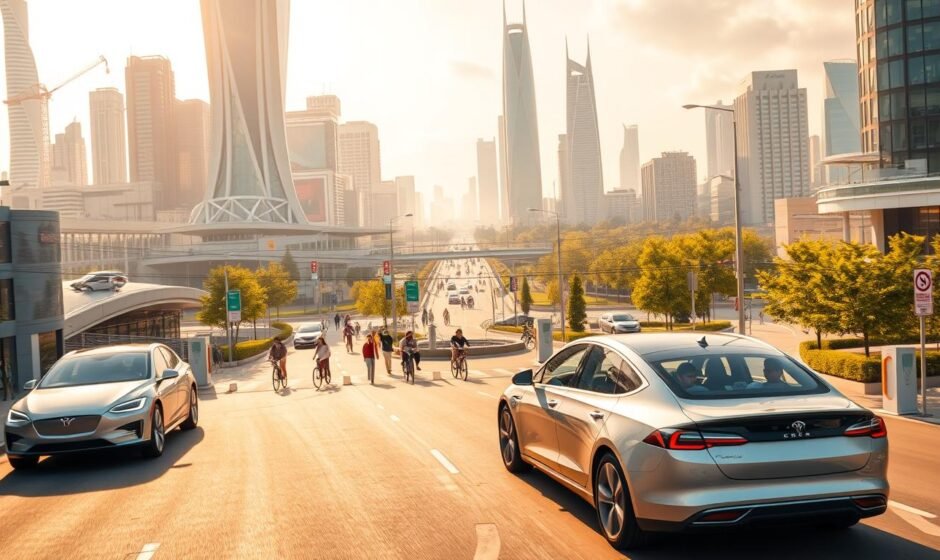Did you know that cars and trucks cause 16.2% of all global CO2 emissions? Most vehicles run on fossil fuels, making electric cars a must for *reducing pollution*. As we move towards an electric future, it’s clear that *eco-friendly electric cars* are a cleaner choice than old engines.
The world now has over 16 million electric vehicles. They are most common in China, Europe, and the U.S. It’s important to understand how electric cars help our planet. They are key to making transport more sustainable.
Key Takeaways
- Electric vehicles play a critical role in decreasing harmful emissions.
- The shift to EVs is vital for meeting climate goals, including a reduction in global warming.
- Air quality improvements are evident in urban areas embracing electric transport.
- Technological advancements are making electric cars more sustainable.
- Government incentives are key to getting more people to use EVs.
- Challenges like infrastructure need to be solved to fully benefit from EVs.
- The future of transport is electric, with EVs at the heart of smart cities.
The Rise of Electric Vehicles and Their Importance
The story of electric vehicles is a journey through time, filled with key moments. These moments have made electric cars important today. As we face pollution and sustainability issues, it’s key to understand EV adoption trends.
The move to electric cars is more than a trend. It shows a big change towards caring for the environment.
Historical Overview of Electric Vehicles
The first electric cars appeared in the 19th century, before gas cars. By the late 1800s, they were a cleaner choice. But, energy prices and battery tech changes made them popular and then less so.
In the late 20th century, better batteries brought back interest. This laid the groundwork for today’s electric car leaders.
Current Trends in EV Adoption
EVs are becoming more popular, thanks to better tech and people knowing more. Sales are expected to hit 17.5 million by 2024. Countries like Norway and Sweden are leading in EV use, thanks to green energy.
Studies show a 25% EV car share could cut air pollution a bit. A 75% shift could make a big difference. The UK aims for all new cars to be zero emission by 2035.
Key Players in the Electric Vehicle Market
Brands like Tesla, Nissan, and Volkswagen lead the electric car market. They’ve pushed the limits of range, speed, and charging times. Their work makes cars better and helps the planet.
These companies are key to a cleaner future. They’re making transportation greener for tomorrow.
| Market Leader | Key Contribution | Electric Vehicle Model | Notable Technology |
|---|---|---|---|
| Tesla | Innovative battery technology and autonomous driving | Tesla Model 3 | Advanced Autopilot |
| Nissan | Accessible electric vehicle options | Nissan Leaf | e-Pedal technology |
| Volkswagen | Mass-market electric vehicle initiatives | ID.4 | MEB platform for modular electric drives |
Understanding Pollution and Its Impacts
Transportation plays a big role in pollution, affecting both our health and the planet. Cars and trucks release harmful emissions that can cause serious health problems. These include breathing and heart issues. It’s important to know how traditional transport methods pollute and harm our environment.
Types of Pollution Associated with Transportation
Transportation emissions mainly include:
- Air Pollution: Particulate matter (PM), nitrogen oxides (NOx), and volatile organic compounds (VOCs) are emitted, exacerbating health risks from air pollution.
- Water Pollution: Runoff from roads can introduce oils and heavy metals into waterways, affecting aquatic ecosystems.
- Greenhouse Gas Emissions: Carbon dioxide (CO2) and methane (CH4) are released, contributing to climate change.
Health Effects of Air Pollution
The health risks from air pollution are serious. Vehicle pollutants can cause:
- Respiratory Issues: Chronic conditions such as asthma and bronchitis can develop or worsen.
- Cardiovascular Diseases: Studies indicate an increase in heart disease related to air quality.
- Neurological Effects: Fine particulate matter can penetrate the bloodstream, potentially impacting brain health.
Environmental Consequences of Emissions
Greenhouse gas emissions from transport have big environmental impacts, including:
- Ecosystem Damage: Changes in climate patterns affect biodiversity and disrupt habitats.
- Climate Change: The transport sector is a major contributor to global warming, with proposed legislation aiming to cut CO2 emissions from vehicles significantly.
- Air Quality Deterioration: Toxic smog and haze from emissions have persisted in urban areas for generations, raising concerns about public health.
How Electric Vehicles Reduce Air Pollution
Electric vehicles (EVs) are a big step towards cleaner air. They use new technology to cut down on pollution. This makes cities healthier and more sustainable.
Zero Emissions from EVs
EVs don’t have a tailpipe, so they don’t release harmful pollutants. This means less carbon in the air. Experts say EVs could cut emissions by up to 550 million metric tons by 2050.
This is like taking 100 million cars off the road. It shows how much EVs can help.
Improved Air Quality in Urban Areas
Using EVs makes cities cleaner. They can reduce ozone levels by up to 4 parts per billion. This is good for people’s health.
EVs also cut down on harmful particles in the air. This helps reduce smog. So, living in cities becomes healthier.
The Role of Renewable Energy
Using renewable energy to charge EVs is key. It makes EVs even cleaner. This helps fight pollution and greenhouse gases.
The Technological Advances Driving EV Efficiency
Recent tech advancements are key to making electric vehicles more efficient. Improvements in battery tech, smart charging, and vehicle-to-grid systems boost energy efficiency. This makes electric cars more appealing and sustainable.
Battery Innovations
Battery tech has seen big leaps in energy density and charging times. For example, lithium-ion batteries have gotten 25% more efficient in five years. This means cars like the Nissan Leaf can go further on a single charge.
These improvements also cut down on emissions over a car’s life. This is better for the environment than traditional petrol cars.
Smart Charging Solutions
Smart charging EVs use advanced tech to use energy better. Fast-charging stations can fill up to 80% of a car’s battery in 30 minutes. This cuts down on waiting time for drivers.
With more charging stations coming, EVs will be easier to use. By 2025, there could be 3 million stations. Using renewable energy for charging can cut emissions by up to 70%.
Vehicle-to-Grid Technology
Vehicle-to-grid tech is a game-changer for energy management. It lets EVs send energy back to the grid. This boosts energy efficiency and can earn owners extra money.
By linking EVs to smart grids, cities can better manage energy. This makes energy systems more reliable and cuts down on fossil fuel use.

The car industry is always pushing forward, thanks to these tech leaps. From better batteries to smart charging and vehicle-to-grid, electric cars are getting cleaner and more efficient. They promise a greener future for transport.
Electric vehicles enhance fuel economy, reduce emissions, and support public.
Government Initiatives and Incentives
The move to electric vehicles is boosted by strong government support and incentives. Governments worldwide are working hard to cut emissions and fight climate change. They’re using EV legislation and grants to encourage the use of electric cars, aiming for a greener future.
Legislation Supporting EV Adoption
Many countries offer government incentives for electric vehicles. For example, the UK plans for 80% of new cars and 70% of new vans to be electric by 2030. They hope to make all vehicles electric by 2035. This makes electric cars a more appealing choice for many.
Tax Incentives for Consumers
Tax breaks help make electric vehicles more affordable. These incentives can include big discounts on the car’s price and lower road taxes. As these incentives grow, buying an electric car becomes more appealing compared to traditional cars.
Investments in EV Infrastructure
Building a strong EV infrastructure is key for electric cars to become common. The UK is investing over £2 billion to make this happen. They’re adding more charging stations, with over 48,100 public chargepoints already available. A £381 million fund is also being used to add more chargers, showing a big commitment to electric cars.
More than 120 countries are aiming for zero emissions, with local efforts adding to this goal. Learning more about these efforts can help you understand how government support can help you switch to electric.
| Year | New EV Sales (Units) | Percentage of Total Sales | Investment (£) |
|---|---|---|---|
| 2020 | 2,100,000 | 4.6% | 2 billion |
| 2021 | Not available | Not available | 1.5 billion (projected) |
| 2024 | Projected Increase | 22% of new cars | 381 million (LEVI fund) |
Challenges Facing Electric Vehicle Adoption
Electric vehicles face several challenges that slow their adoption. These include high costs, limited charging spots, and consumer worries. Knowing these issues helps both buyers and policymakers to make the switch to electric cars easier.
High Upfront Costs
Electric cars are pricey at first. They cost more than gas cars because of expensive batteries. Even though they save money in the long run, the high start-up cost is a big worry for many.
Limited Charging Infrastructure
There aren’t enough charging spots for electric cars. This is a big problem in rural areas where charging is hard to find. We need more charging points to make electric cars more accessible.
Range Anxiety Among Consumers
Many people worry about how far electric cars can go on one charge. Even though some models can go over 300 miles, it’s not as far as gas cars. Charging an electric car takes a long time, which adds to the worry. These concerns make people hesitant to choose electric cars.

| Challenge | Description |
|---|---|
| High Upfront Costs | Electric vehicles generally cost more due to expensive battery technology, deterring many buyers. |
| Charging Infrastructure Issues | There aren’t enough charging spots, making it hard to use electric cars, even in rural areas. |
| Range Anxiety | People are worried about the limited range and long charging times of electric cars compared to gas cars. |
The Future of Electric Vehicles and Sustainability
The world of urban transport is changing fast with electric vehicles leading the way. These changes will make cities smarter and better places to live. The rise of electric cars, including self-driving ones, shows a big leap in how we travel. It’s all about making transport greener and safer.
Integration with Smart Cities
Smart cities are using tech to make life better, and electric cars are key. They help manage traffic and use less energy. By linking up with smart grids, they also cut down on pollution.
The Role of Autonomous Driving
Autonomous electric cars are a big step towards a greener future. They drive themselves, which could make roads safer and easier to use. Plus, they use less energy, helping us reach our green goals faster.
Long-Term Environmental Goals
Switching to electric cars is a big step towards saving our planet. Cars are a big source of pollution, so moving to electric helps a lot. As more countries go electric, we’ll see big improvements in air and energy use. It’s all about making the world a cleaner place for everyone.
Case Studies: Successful EV Implementation
Cities around the world are leading the way in electric vehicles (EVs). They’ve seen big improvements in air quality and less pollution. By looking at these cities, we can learn how to make transportation greener and understand the future of cars.
Cities Leading the Charge
Some cities are at the top when it comes to EVs. California is a big example, with plans to make 12% to 15% of new cars electric by 2025. This push has changed the market and encouraged more people to choose electric cars. Amsterdam and London are also making it easier to charge cars, showing how important access is.
Lessons from Global Leaders in EV Adoption
There’s a lot to learn from how cities have adopted EVs. One key thing is the role of laws. For example, tax breaks can make electric cars more appealing, with credits up to $7,500. Also, building more charging spots is essential, with a 20% yearly increase needed by 2025.
Stories from these cities show that the right mix of laws, infrastructure, and awareness can make a difference. With EV sales expected to soar over 20 million by 2025, learning from these leaders is key for others to join the electric revolution.
Conclusion: A Roadmap for Sustainable Transport
We are at a turning point in transport, and a sustainable transport roadmap is key. Electric vehicles (EVs) can cut air pollution and greenhouse gas emissions by 85%. By choosing EVs, you save money and help clean the air and improve public health.
The future of electric vehicles is bright, with Norway leading in electric car sales. China is also making a big impact with its EV production and infrastructure. To encourage more people to switch, we need cheaper EVs and more charging points.
It’s time for everyone to work together. Governments, industries, and consumers must join forces. This collaboration can lead to a greener future, with cleaner roads and healthier communities.




